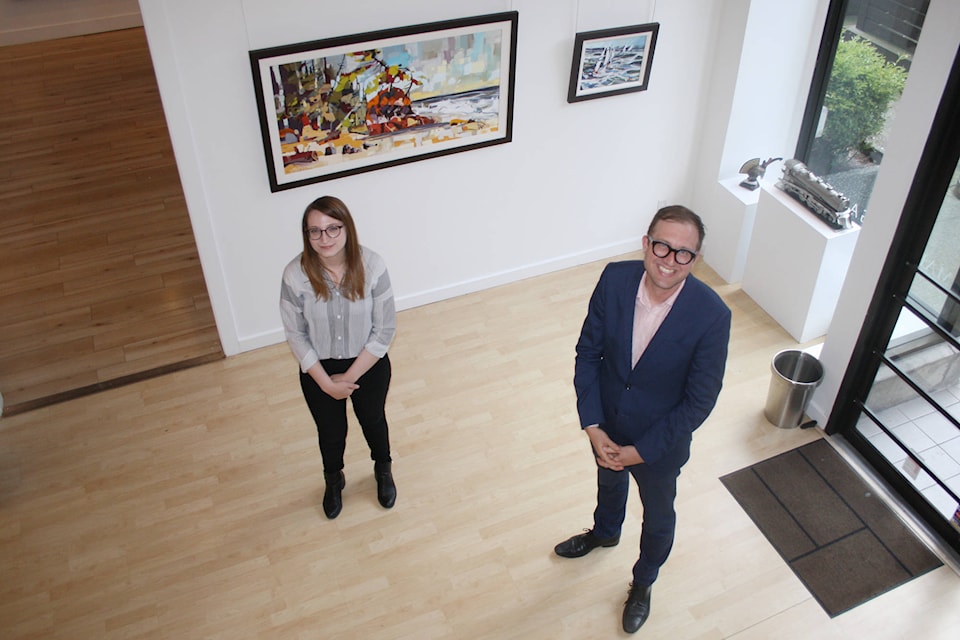On the cusp of its 10th anniversary, Madrona Gallery’s owner recalled starting as a local gallery that might not be here today if COVID-19 had come along during its first two years.
The downtown store, which is accessible from View Street and Trounce Alley, is currently hanging a wall-sized Ted Harrison, Glorious Lone Land, a five-foot by seven-foot piece from 1990 that recently sold to another dealer.
Their new exhibition will feature guest pieces from Madrona’s stable of artists, Meghan Hildebrand, Nicholas Bott, Clayton Anderson, Sean Yelland, and others. It is also showing historic and post-war works by E. J. Hughes, Takao Tanabe, Harrison, and members of the Group of Seven.
It didn’t start that way, but Madrona owner Michael Warren has become a savvy art dealer who has overseen the sales of seminal works by Canadian greats including Hughes, Tom Thomson, Emily Carr, Lawren Harris, Franklin Carmichael, Jean-Paul Riopelle, Tik-Tak, Pauta Saila and Kenojuak Ashevak.
| Ted Harrison's Glorious Lone Land, 1990, a five-foot by seven-foot painting hanging in Madrona Gallery ahead of the store's 10th anniversary. (Madrona Gallery/Ted Harrison) |
But those types of sales are not what Warren and his partner Theresa McFarland made when they started the gallery in June of 2010.
“In a lot of ways it feels like just yesterday we were opening the gallery and learning how to swim,” Warren said. “But we’ve done a lot. The business has grown, going from a local focus with a local footprint to sourcing work nationally and internationally.”
READ MORE: Behind the bronze sculpture at Oak Bay’s Haynes Park
About 13 years ago, Warren was an employee a few metres down View Street in the West End Gallery when he was poached and took an offer to work in a Whistler gallery. That’s when the art history major and McFarland, an historian, hatched plans to open their own space on View. He was there for two years before they opened Madrona.
What stands out about Madrona, especially right now with a series of Hughes pieces on the wall, is how they mix classics and contemporaries, often West Coast but not always.
“We try to connect the dots in terms of the story of Canadian art, which is always changing, but it’s great for us to show works like [Ted Harrison], past artists that influence other artists who are still alive,” Warren said. “Take Clayton Anderson, and then check this out next to a Hughes, and all of a sudden you’ve got this really interesting collection.”
Still, they continue to deal in everything, which means encouraging local emerging artists to build their career, to having a rare Thomson piece which will eventually sell in the millions.
The classics don’t always sell right away, and that’s okay, he said. Having pieces from a seminal artist come through the gallery can be a way to balance and contextualize a buyer’s comfort level.
READ ALSO: Harrison leaves behind colourful legacy
“Buyers can sometimes be anxious, not matter what level you’re spending at, you want to make sure you’re informed and comfortable with the decision,” Warren said.
The gallery is soon to say goodbye to the Harrison piece, Glorious Lone Land. Warren believes it is likely Harrison’s biggest work.
“It’s a really rare important piece of Ted Harrison,” Warren said. “He is probably the most important artist of the Yukon. We spotted this in an auction in Toronto, and really wanted to bring it back to Victoria. People around here want the best of Harrison’s work.”
Things are going well now but it wasn’t always easy.
“The first two years [McFarland] worked and that allowed me to put all my time, energy and money into the gallery,” Warren said. “We wouldn’t have survived without her working. I basically didn’t pay myself for those couple of years.”
Looking back, a COVID-19 pandemic would have been disastrous, he said. In surviving, that time allowed them to build a stable of artists and to become the gallery they are.
“There were times when we were new, there were artists or people that we thought were a going to be a good fit for the market and, even though the works were great, it just didn’t have a commercial market here,” Warren said. “Sometimes you fail, and then you learn and adapt to a new level of knowledge, and try to do better the next time.”



